Shop sim racing equipment
[adinserter name=”Elgato”]
[adinserter name=”GT Omega”]
The Simucube Valo GT-23 is a case of seduction by substance. Optimal functionality and build quality are its leading assets, and despite a more tempered stealth-like look than many of its competitors, this sim racing wheel earns your attention.
Let’s start with the fundamentals. The Valo GT-23 is a wireless wheel with a D-shaped alcantara rim, RGB LED lights and a diameter of 320mm. A retail price of £784.93 at the time of writing (£870.14 if you include the Simucube link required for those who don’t own one already) demonstrates clear intentions for who this wheel is aimed at, and it’s not those on a tight budget.
However, there are plenty of redeeming features that justify its relative market position.
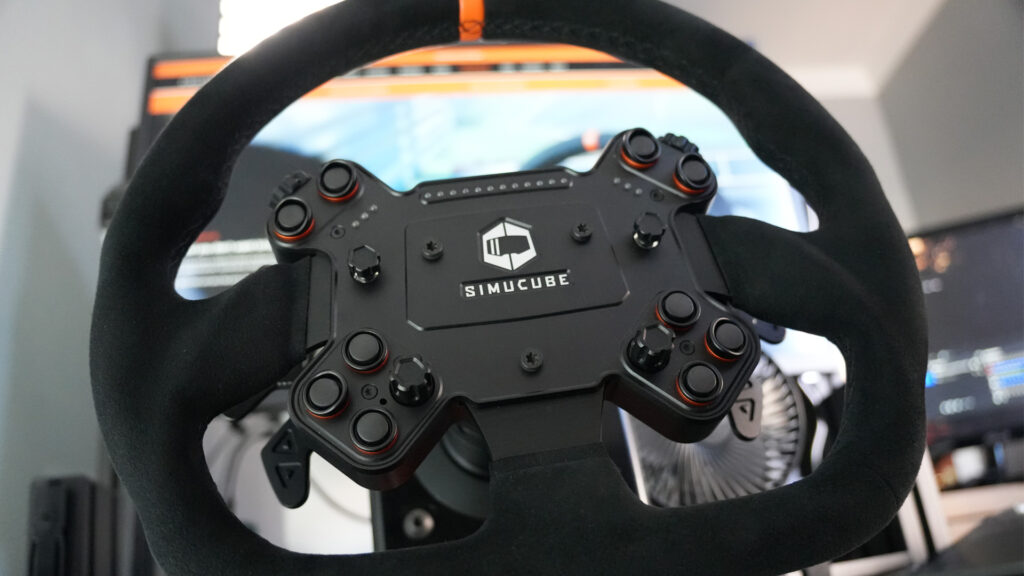
The plethora of buttons, encoders and joysticks sprawled across the anodized aluminum base plate might just be the best example of the obvious functionality focus. I don’t think I have ever experienced a steering wheel with a better layout or range of inputs.
10 supple and tactile buttons, surrounded by elegant orange and black shoulders, all within a thumbs reach minus a small hand slide, plus 2 rotary encoders at the top (again, easy to reach with your thumbs) and two rotary knobs at the bottoms that can be adjusted on a straight.
These knobs and encoders, just like the buttons, are relatively soft, and easy to turn with minimal force. But despite this, there is no sense of vagueness; it’s all subtle yet purposeful. And as each of these can also be pressed in, that adds four more useful click based inputs.
Separating the top and bottom half are a pair of clickable and rotational joysticks; the perfect finishing touch that takes the inputs from an A- to an A+. These are most welcome in the world of sim racing, where having a D-pad equivalent significantly improves the overall usability.
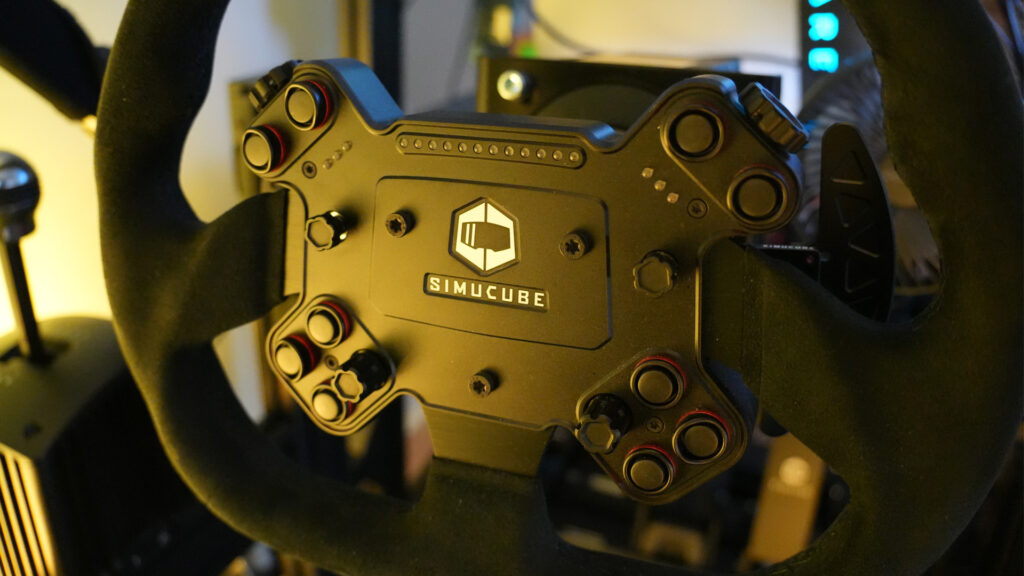
Games are often designed around the use of a controller, and when sim steering wheels are too focused on realism and not practicality, this gets overlooked. With the Valo GT-23, menu navigation and in-car management are a relative breeze, with or without the use of a mouse and keyboard, and regardless of whether you are wearing gloves or not.
The reason I mention gloves specifically is that the authentic Alcantara finish to the rim will encourage the use of a pair. It would be nice to see an option of another material here in future, as Alcantara isn’t everyone’s cup of tea. It can look a little tired if not maintained properly, and without the use of gloves, it may result in stained hands after a stint.
But as somebody whose hands are softer than the suspension on a Rolls-Royce Phantom, I wear gloves anyway to protect myself from blisters, and none of this was an issue. After four months of vigorous use, it still looks and feels as good as new.
There is no denying the overall mass of the Valo GT-23. It weighs over 2kg, more than most wheels on the market, and its 320mm diameter and D-shaped configuration make it a bit of a giant.

Despite this, its overall comfort makes it versatile across the various racing disciplines. I raced IndyCar on iRacing, GT3s on Le Mans Ultimate and historic prototypes on rFactor 2 using this steering wheel, without any sense of impracticality.
However, if you are into drifting and/or rallying, despite this still being far more usable than a formula-style wheel in this scenario, you may want to explore a fully round alternative. For any serious circuit racing, this is more diverse than its size suggests, and the force feedback translates wonderfully through the frame. It is also as solid as you would expect, with very little flex in the chassis when twisting.
As with most ‘high-end’ wheels these days you will find paddle shifters at the back, these being some of the quietest and most delicate I’ve experienced. A pair of clutch paddles can be found underneath, allowing for bite-point customisation that can be configured using Simucube’s Tuner software. And this software also allows you to customise the RGB LEDs along the top of the faceplate.
This wheel is the first wireless Simucube with integrated lights, and despite its understated appearance on first glance, the options are fairly extensive.
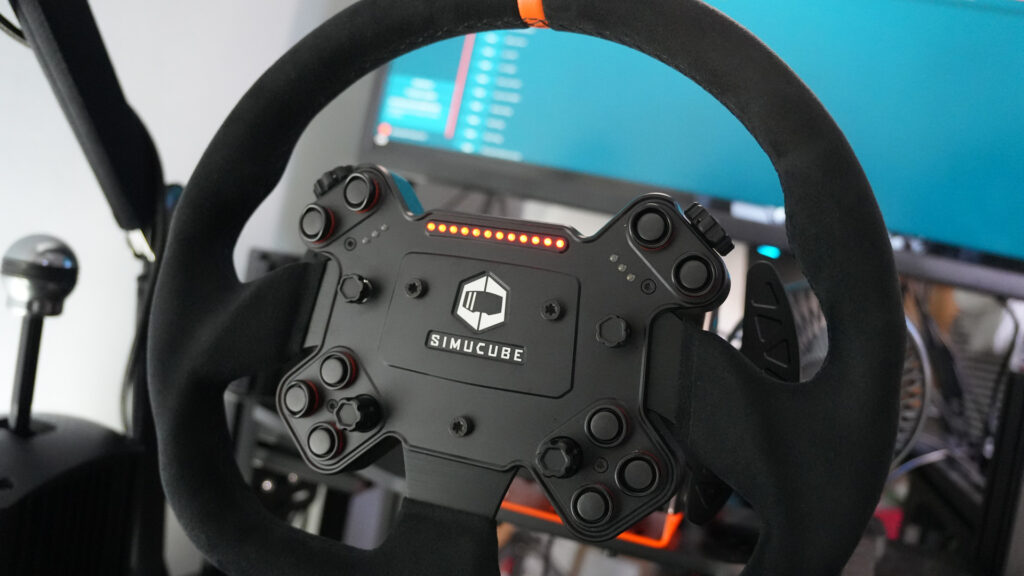
The horizontal strip of shift lights can take on a basic GT or Formula profile, affecting their style and direction, whilst the additional six ‘side’ lights (three on each side) can be programmed to show various telemetry types, from in-game flags, to abs and traction control activation, adjacent car detection and much more.
Of course, with these side lights being small and low in quantity, the information delivery is subtle, but it’s there if you want it.
The software isn’t quite as optimized as you might expect on this front however, with the UI causing a bit of confusion when trying to configure the activation of the rev-based shift lights.
I also found myself having to contact Simucube support for a workaround when trying to connect the wheel to the software. With a Simucube Active Pedal, the Valo GT-23 and a wheel base all in use, I required two separate Simucube applications (Tuner and True Drive), both of which were in use simultaneously. I needed the wheel to speak to Tuner instead of True Drive for access to the available customization settings, but initially, this wasn’t working. As it turns out, I needed to ‘forget’ the wheel within True Drive and prevent it from automatically connecting to that software first…
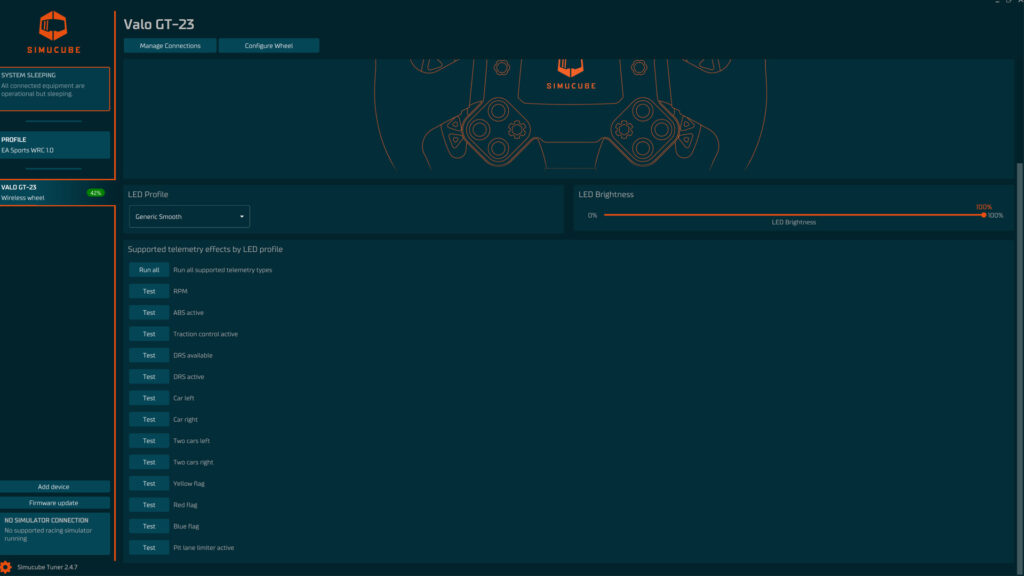
Once sorted, I had zero issues, but I feel like this whole process could have been more user-friendly.
When testing the GT-23, I was intrigued to see how I would get on with a wireless battery-powered wheel that requires charging. Having no cables only adds to the cleanliness of the overall product, but you might be wondering if the fear of a depleting battery is a warranted inconvenience.
I am happy to report that the 2000mAh capacity eradicates any concerns. Battery life feels endless, and in 4 months, I have chosen to charge it a total of three or four times, having never reached the stage of a low battery warning. Nowhere was the extensive battery life made clear before using the Valo, but in reality this concern was well and truly quashed.
The underlying theme with this wheel for me, is understated performance. It does everything brilliantly but doesn’t shout about it. Yes, you pay for the privilege, and with a price point nearing three figures, this had to be good.
But like so many other Simucube products, the value shines through the more you use it, and you feel rewarded for trusting quality over ostentatious rhetoric.
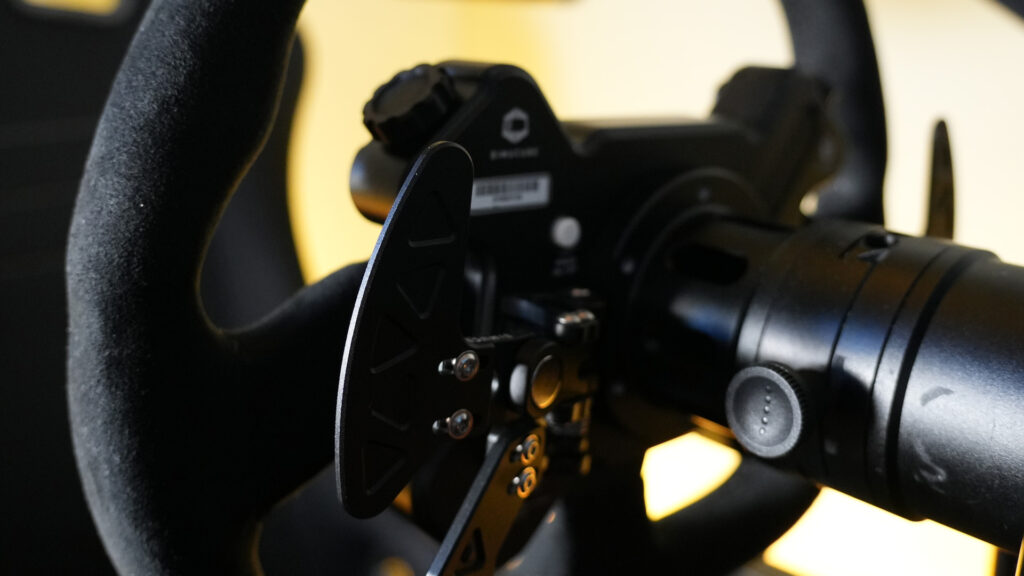





Chat with the Community
Sign Up To CommentIt's completely Free